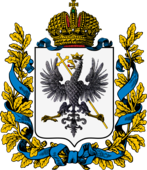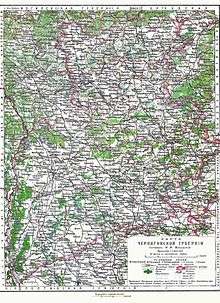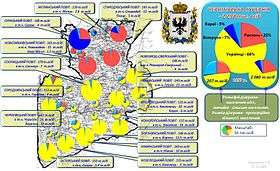Chernigov Governorate
The Chernigov Governorate (Russian: Черниговская губерния; translit.: Chernigovskaya guberniya), also known as the Government of Chernigov, was a guberniya in the historical Left-bank Ukraine region of the Russian Empire, which was officially created in 1802 from the Malorossiya Governorate with an administrative centre of Chernigov. The Little Russian Governorate was transformed into the General Government of Little Russia and consisted of Chernigov Governorate, Poltava Governorate, and later Kharkov Governorate.
| Chernigov Governorate Черниговская губернія | |||||||||
|---|---|---|---|---|---|---|---|---|---|
| Governorate of Russian Empire | |||||||||
| 1802–1918 | |||||||||
 Coat of arms
| |||||||||
 Chernigov Governorate 1903 | |||||||||
| Capital | Chernigov | ||||||||
| Area | |||||||||
• (1897) | 52,396 km2 (20,230 sq mi) | ||||||||
| Population | |||||||||
• (1897) | 2298000 | ||||||||
| History | |||||||||
• Established | 27 February 1802 1802 | ||||||||
• Disestablished | 1 August 1918 1918 | ||||||||
| Political subdivisions | uezds: 15 | ||||||||
| |||||||||
| Today part of | Chernihiv Oblast Kiev Oblast Bryansk Oblast | ||||||||

Chernigov Governorate borders are roughly consistent with the modern Chernihiv Oblast, but also included a large section of Sumy Oblast and smaller sections of the Kiev Oblast of Ukraine, in addition to most of the Bryansk Oblast, Russia.
Administrative division
The governorate consisted of 15 uyezds:
- Borznyansky Uyezd
- Glukhovsky Uyezd
- Gorodnyansky Uyezd
- Kozeletsky Uyezd
- Konotopsky Uyezd
- Krolevetsky Uyezd
- Mglinsky Uyezd
- Nezhinsky Uyezd
- Novgorod-Seversky Uyezd
- Novozybkovsky Uyezd
- Ostersky Uyezd
- Sosnitsky Uyezd
- Starodubsky Uyezd
- Surazhsky Uyezd
- Chernigovsky Uyezd[1]
The Chernigov Governorate covered a total area of 52,396 km², and had a population of 2,298,000, according to the 1897 Russian Empire census. In 1914, the population was 2,340,000. In 1918 it became part of Ukraine and transformed into Chernihiv Governorate.
Principal cities
- Russian Census of 1897
- Nezhin – 32,113 (Ukrainian – 21,733, Jewish – 7,578, Russian – 2,366)
- Chernigov – 27,716 (Ukrainian – 10,085, Jewish – 8,780, Russian – 7,985)
- Konotop – 18,770 (Ukrainian – 10,290, Jewish – 4,415, Russian – 3,565)
- Novozybkov – 15,362 (Russian – 11,055, Jewish – 3,787, Belorussian – 303)
- Glukhov – 14,828 (Ukrainian – 8,621, Jewish – 3,837, Russian – 2,217)
- Borzna – 12,526 (Ukrainian – 10,846, Jewish – 1,515, Russian – 109)
- Starodub – 12,381 (Russian – 7,255, Jewish – 4,897, Ukrainian – 133)
- Krolevets – 10,384 (Ukrainian – 8,328, Jewish – 1,815, Russian – 209)
- Berezna – 9,922 (Ukrainian – 8,349, Jewish – 1,354, Russian – 144)
- Novgorod-Seversky – 9,182 (Ukrainian – 4,884, Jewish – 2,941, Russian – 1,296)
- Mglin – 7,640 (Russian – 4,840, Jewish – 2,675, Belorussian – 75)
- Sosnytsia – 7,087 (Ukrainian – 5,068, Jewish – 1,840, Russian – 158)
- Korop – 6,262 (Ukrainian – 5,309, Jewish – 865, Russian – 77)
- Oster – 5,370 (Ukrainian – 3,229, Jewish – 1,596, Russian – 399)
- Kozelets – 5,141 (Ukrainian – 2,834, Jewish – 1,632, Russian – 468)
- Pogar – 4,965 (Russian – 3,800, Jewish – 1,159, Germans – 6)
- Gorodnya – 4,310 (Ukrainian – 2,349, Jewish – 1,248, Russian – 604)
- Surazh – 4,006 (Jewish – 2,400, Belorussian – 978, Russian – 559)
- Novoye Mesto – 1,488 (Russian – 1,421, Jewish – 67)
Language

- By the Imperial census of 1897.[2] In bold are languages spoken by more people than the state language.
| Language | Number | percentage (%) | males | females |
|---|---|---|---|---|
| Ukrainian | 1,526,072 | 66.41 | 747,721 | 778,351 |
| Russian | 495,963 | 21.58 | 236,842 | 259,121 |
| Belarusian | 151,465 | 6.59 | 73,691 | 77,774 |
| Yiddish | 113,787 | 4.95 | 54,724 | 59,063 |
| German | 5,306 | 0.23 | 2,664 | 2,642 |
| Polish | 3,302 | 0.14 | 1,775 | 1,527 |
| Persons that didn't name their native language |
74 | >0.01 | 32 | 42 |
| Other[3] | 1,885 | >0.01 | 1,247 | 638 |
| Total | 2,297,854 | 100 | 1,118,696 | 1,179,158 |
References and notes
- Генеральная карта Черниговской губерніи Съ показаніемъ почтовыхъ и большихъ проъзжихъ дорогъ, станціи и разстоянія между оными верстъ – Ст. Петербургъ, 1829. (in Russian) (Page title read as: "General map of the Chernihiv province. St. Petersburg, 1829.")
- Language Statistics of 1897 Archived 22 June 2011 at the Wayback Machine (in Russian)
- Languages, number of speakers which in all gubernia were less than 1000
External links
- Chernigov Guberniya – Article in Brockhaus and Efron Encyclopedic Dictionary (in Russian)
- Chernigov Governorate – Historical coat of arms (in Ukrainian and English)
- Chernihiv gubernia – Article in the Encyclopedia of Ukraine